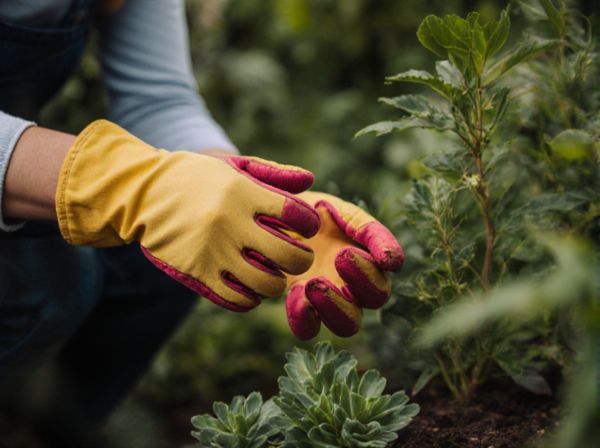
Dormancy Breaking vs Natural Germination Illustration
Dormancy breaking involves artificial methods such as scarification, stratification, or chemical treatments to stimulate seed germination by overcoming physiological or physical barriers. Natural germination occurs when environmental conditions like temperature, moisture, and light naturally trigger the seed to sprout without human intervention. Understanding the differences between these processes helps optimize seed propagation for agriculture, horticulture, and conservation efforts.
Table of Comparison
| Aspect | Dormancy Breaking | Natural Germination |
|---|---|---|
| Definition | Artificial methods to overcome seed dormancy | Seed sprouting under natural environmental conditions |
| Trigger | External interventions (scarification, stratification, chemicals) | Natural temperature, moisture, light, and soil conditions |
| Timeframe | Shortened germination period due to treatment | Variable, often longer due to natural environmental cycles |
| Control | High control over timing and success rates | Less control, dependent on environment and seed viability |
| Application | Used in agriculture, horticulture, forestry for uniform germination | Occurs in natural ecosystems without human intervention |
| Effectiveness | Improves germination percentages in dormant seeds | Germination may be inconsistent due to dormancy barriers |
Understanding Seed Dormancy in Gardening
Seed dormancy prevents germination until environmental conditions are favorable, serving as a natural survival mechanism in gardening. Dormancy breaking techniques such as stratification, scarification, or chemical treatments are employed to simulate these conditions and promote uniform seed sprouting. Understanding the biological mechanisms of dormancy enhances effective seed propagation strategies and improves seedling establishment success rates.
What is Natural Germination?
Natural germination is the process where seeds sprout and grow under favorable environmental conditions without human intervention. It relies on natural factors such as temperature fluctuations, moisture availability, light exposure, and microbial activity to break seed dormancy. This contrasts with dormancy breaking techniques that use artificial methods like scarification, stratification, or chemical treatments to stimulate seed germination.
Factors Influencing Seed Dormancy
Seed dormancy is primarily influenced by environmental factors such as temperature fluctuations, moisture levels, and light exposure, which affect hormonal balances within the seed. Chemical inhibitors like abscisic acid play a crucial role in maintaining dormancy until favorable conditions trigger germination. Mechanical constraints, such as hard seed coats, also contribute to dormancy by preventing water uptake and gas exchange, requiring physical or chemical processes to break dormancy.
Methods of Dormancy Breaking in Seeds
Dormancy breaking methods in seeds include stratification, which exposes seeds to cold, moist conditions mimicking winter, and scarification, which physically or chemically alters the seed coat to enhance water absorption. Other techniques involve soaking seeds in water or treating them with gibberellic acid to stimulate germination hormones. These approaches accelerate germination by overcoming physiological or physical dormancy barriers that naturally prevent immediate seed sprouting.
Mechanical vs Chemical Seed Treatments
Mechanical seed treatments such as scarification physically break or weaken the seed coat to facilitate water uptake and overcome dormancy, commonly used for hard-coated seeds like legumes. Chemical treatments involve the application of substances like gibberellic acid or sulfuric acid to mimic natural processes, breaking dormancy by altering seed coat permeability or triggering biochemical changes. Both methods enhance germination rates by effectively addressing different dormancy mechanisms, with mechanical treatments relying on physical disruption and chemical treatments targeting physiological constraints.
Environmental Triggers for Natural Germination
Environmental triggers for natural germination include temperature fluctuations, light exposure, and moisture levels, which signal optimal conditions for seed growth. These triggers overcome seed dormancy by activating metabolic processes necessary for sprouting, such as breaking down growth inhibitors and enhancing enzyme activity. Seeds adapted to specific ecosystems rely on cues like seasonal temperature cycles or fire events to initiate natural germination without artificial dormancy breaking methods.
Advantages of Dormancy Breaking Techniques
Dormancy breaking techniques accelerate seed germination by overcoming physiological and physical barriers that naturally delay sprouting, leading to uniform and faster crop establishment. These methods enhance seed viability and improve emergence rates, which are critical for optimizing agricultural productivity and reducing time to harvest. Controlled dormancy breaking also enables better synchronization with environmental conditions, increasing the chances of successful seedling development compared to natural germination.
Pros and Cons of Natural Germination
Natural germination allows seeds to sprout under authentic environmental conditions, promoting genetic diversity and adaptation to local ecosystems. However, reliance on natural germination can lead to inconsistent growth rates and lower germination percentages due to variable factors such as temperature, moisture, and soil quality. The absence of dormancy-breaking treatments may delay germination, potentially reducing plant establishment success in controlled agricultural or reforestation projects.
Dormancy Breaking in Difficult-to-Germinate Seeds
Dormancy breaking techniques accelerate germination in difficult-to-germinate seeds by overcoming physiological or physical barriers, such as hard seed coats or chemical inhibitors. Methods like scarification, stratification, and chemical treatment optimize seed viability and uniform emergence rates compared to natural germination conditions. These interventions enhance seedling establishment in species with prolonged dormancy periods, improving propagation success in agriculture and restoration ecology.
Best Practices for Successful Seed Germination
Dormancy breaking techniques, such as scarification, stratification, and chemical treatments, enhance seed germination by overcoming physiological or physical barriers that inhibit sprouting. Natural germination relies on environmental cues like temperature fluctuations, moisture, and light exposure to initiate seed growth, mimicking conditions in the seed's native habitat. Best practices for successful seed germination involve selecting appropriate dormancy-breaking methods tailored to specific seed types and ensuring optimal environmental conditions to maximize germination rates and seedling vigor.
Dormancy Breaking vs Natural Germination Infographic

 gardendif.com
gardendif.com